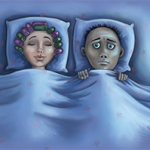To Be or Not To Be A Morning Person
Taken together, these observations readily explain why most patients with RA don’t consider themselves to be morning people. In fact many of us hate starting our days at the crack of dawn. Mornings are relatively stressful times for our bodies. The probability of nontraumatic death, as well as stroke, ST-elevation myocardial infarction, and ventricular arrhythmia, varies by time of day, with a peak occurring in the late morning or early afternoon. In a recent long-term study of candidate gene associations in patients with sleep disorders, it was observed that among a large cohort of older patients, two common polymorphisms near the PER1 gene, a key regulator of circadian rhythms, could segregate individuals into either early or late risers.8 Among those who died of natural causes, the presence of the early-riser polymorphism correlate with the likelihood of a mid- to late morning time of death, while the late-riser polymorphism was associated with the individual’s death occurring seven hours later, in the early evening. Tick, tock; chronobiology can be eerie.
Timing Is Everything
In life, and even in death, timing may be everything. This was further highlighted using a creative approach that demonstrated how experimentally induced circadian disruption that mimicked jet lag altered innate immune responses. By regularly shifting the light–dark cycles in a group of mice that were exposed to the hazards of lipopolysaccharide (LPS)-induced septic shock, investigators found an enhanced mortality rate of 895, compared to just 21% in the unshifted control mice.9 Although sleep deprivation and stress are known to alter immune function, polysomnographic recordings in the mice exposed to the shifting schedule revealed no sleep loss, and stress measures were not altered in the shifted mice.
In contrast, the authors observed altered or abolished rhythms in the expression of clock genes, not only in the central clock, but also in the liver, thymus, and peritoneal macrophages. Is it possible that circadian disruption, rather than simply sleep loss or stress, is responsible for the jet lag–related dysregulation of the innate immune system seen in shift workers? Perhaps this would explain why a lovely patient of mine, Patty, with longstanding, well-controlled RA, recently experienced what she described was the “worst flare-up of her life.” Her therapeutic regimen had not changed; she had not been ill, nor had she traveled. However, for the past four weeks, her nursing shift working in a cardiac care unit had been changed from daytime duty to an overnight shift. This single alteration appeared to be responsible for her RA disease activity score to have nearly tripled from its usually steady baseline value. Though Patty’s case was extreme, I am certain that over the years I have missed other more subtle examples of shift work affecting disease activity.

